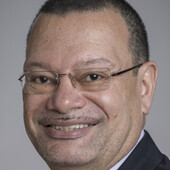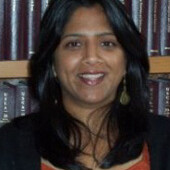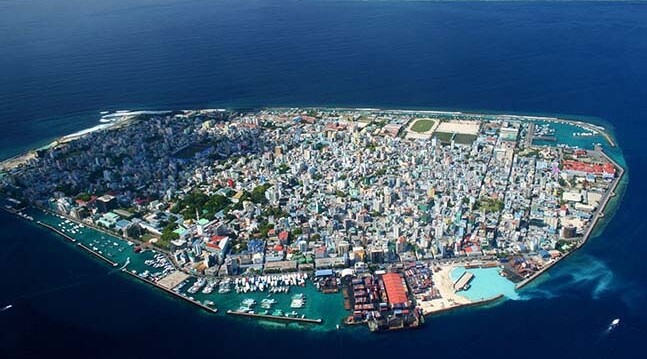We are already living with climate change; and although countries have pledged to limit global warming to 2 °C, success seems highly unlikely. This panel explores how to advance ethical leadership on climate justice globally, nationally, and locally in the years ahead. Topics include the Paris Agreement and commitments going forward, geoengineering governance, the problems in California, and the creative ways the Seychelles are coping.
This Ethics & International Affairs roundtable took place at the International Studies Association (ISA) Annual Convention in San Francisco.
JANOS PASZTOR: Good afternoon. Welcome to this session. We will be talking about climate change, climate justice, and some related ethical issues. My name is Janos Pasztor. I am a senior fellow at the Carnegie Council, and I am executive director of the Carnegie Climate Geoengineering Governance (C2G2) initiative. This is not a session about geoengineering governance, but the issue might come up, since that itself raises many interesting ethical questions.
Basically, I'll do a quick introduction including an introduction of the speakers. Then I will ask our speakers to say a few words, to basically state their main issue, and then I will try to facilitate a discussion, first between the panel members, and then hopefully you will have some difficult questions to ask, and then there will be a session on Q&A. I believe we need to finish by 3:30 at the latest, so we have basically an hour and a half to do what we need to do.
With that, climate change, we're not in very good shape to say the least. It's a hot topic, and it's a hot topic in every sense of the word. Of the last 17 years, 16 of them were the hottest ever, and I am pretty sure that there will be more hottest years coming in the future.
Global emissions should be going down rapidly, and they are not going down rapidly. In fact, they are going up. We had a few years where it was kind of stable, the global emissions level, and now again it has started going up. That is pretty bad.
The impacts of climate change are also pretty serious. There was a time when we talked about climate change, you said, "That's going to happen sometime in the future." Now we are in a situation where climate change is there, it's there today, and the impacts are there today, and the impacts are hurting people of today, and they may hurt people in the future as well and maybe even more so, but they are already here today.
Just look at the Arctic. The Arctic is disappearing in front of our own eyes, in the sense of these eyes. Look at the hurricanes in the Caribbean and elsewhere. There are very serious impacts that are now increasingly scientifically attributable to climate change.
So it is going to be difficult to say that this particular weather event or that particular event is due to climate change, but I think there is an increasingly quality science called attribution science that is increasingly able to say that in fact what you are seeing is climate change.
Unfortunately, the gap between what we should be doing as the world and what the world is actually doing is very big. According to a recent study by the UN Environment Programme, we are about 30 percent of the ambition level of what we should be doing for a 2° C world. That is 30 percent. That is just a third.
So we are very far from where we should be. There is just simply insufficient leadership, political, economic, and otherwise. Unfortunately, what is happening in this country—the United States—is not helping. Yet this is the country that is not only one of the largest emitters, but it is the country that potentially would have the technology, the finance, and the push to be able to really address the problem itself and help everybody else to address the problem. So we are in a difficult situation.
This is the context in which we are going to have our discussion. I am not going to talk any more. My job is to facilitate, not to spend a lot of time.
What we would like to do is try to bridge the gap between theory and practice and try to provide ethical leadership on these issues and to increase climate justice. These little things: climate justice; ethical leadership.
That is what we are going to do. We have a fantastic panel here, four colleagues who will be speaking on those different issues from very different perspectives. So let me introduce them quickly one by one, and then I will ask them to speak.
Our first speaker will be Darrell Moellendorf right here. Darrell is professor of philosophy at the Goethe University in Frankfurt. He writes on issues of global justice and ethics broadly, but his recent work has focused on climate justice, particularly intergenerational issues. Thank you very much for coming.
Our second speaker will be Robyn Eckersley. Robyn, thank you. She is a professor of political theory and philosophy at the University of Melbourne, specializing in environmental politics and ethics and governance of climate change. Past research focused on responsibility for climate change and climate justice, and current research focuses on climate leadership, particularly among developed countries. So, thank you.
Our third speaker will be Suma Peesapati. Suma, thank you for coming. She is president of Communities for a Better Environment (CBE)—not to be confused with the British Empire—and former staff attorney at the University of California, Irvine, Environmental Law Clinic. CBE is an environmental justice organization focusing on preventing and reducing pollution which affects low income and minorities more than others, and she is based in Los Angeles.
Our last speaker will be Ronny Jumeau. Ronny Jumeau is from the Seychelles. He is ambassador to the United States. He is also ambassador to the United Nations. He is also ambassador-at-large on climate change issues related to Small Island Developing States (SIDS). We have three-in-one. So we actually have a panel of six people.
Thank you very much, colleagues and panelists, for being here. I think we should get going. I would like to start with Darrell. Darrell will talk about the Anthropocene and how climate change takes place and what is the impact of the Anthropocene thinking on climate change.
DARRELL MOELLENDORF: Thanks for the opportunity to be here and to speak.
I don't know if the term "Anthropocene" is familiar to you; probably to some extent. It has come into increasing usage. It has not yet received official scientific sanction, although it is used in many cultural discussions, and it's also used among scientists to represent a new geological epoch that follows on the Holocene, which was this period that lasted about 10,000 years.
The "anthropo-" part of that, of course, is supposed to signify that this is an epoch is marked by a distinct and irreversible set of human signatures on planetary systems, including the Earth's crust. That is the interest amongst geological scientists.
I think for our purposes probably the planetary system that is the most interesting for the discussion of this panel is the climate system itself. What differentiates the Anthropocene in this regard from the Holocene is the level of CO2 and other greenhouse gases in the atmosphere that far exceed the levels that were average fluctuations during the Holocene period. We are currently somewhere over 400 parts per million of CO2; in the atmosphere of the Industrial Revolution it was something on the order of 279.
This is, of course, important because all of these signatures, but climate change in particular, have effects on the stable functioning of planetary systems.
Carbon dioxide concentrations in the atmosphere, of course, are what force climate change or what force temperature increase, and these concentrations are a product of CO2 emissions, and because CO2, once it's emitted, stays in the atmosphere for such a long time, it is the cumulative CO2 emissions since essentially the beginning of the Industrial Revolution that make up current concentrations of CO2 in the atmosphere.
The significance of all of that is that if you want to hit a particular temperature target, say 2 °C—it could be 2 °C; it could be 3 °C; it could be 1.5 °C—whatever particular temperature target that you want to hit, that is going to be associated with a set of cumulative emissions of CO2 since the beginning of the Industrial Revolution.
Scientists will tell us that if we want to hit 2 °C that we have to be aware that the total emissions since the beginning of the Industrial Revolution should be on the order of 1 trillion tons. We've already exceeded over half of that.
There is a very nice webpage, by the way, trillionthtonne.org, if you haven't seen that, and it tells us that we will hit the trillionth ton within a very short time.
If we want to address that particular problem, then we're going to have to reduce CO2 emissions dramatically, eventually bringing them to a stop.
The Anthropocene, one of the things that makes this a difficult discussion, is that it is a side effect of a process that we have plenty of reason to value, and this is the process of industrialization that has increased living standards, unevenly of course, but virtually around the world. Living standards since the beginning of the Industrial Revolution have increased tremendously. Economic growth has been about 1000 percent since the beginning of the Industrial Revolution. Now the average monthly income of a person in the world is €720. At the beginning of the Industrial Revolution it was €70, and that is an adjusted income.
Life expectancy over this period has increased virtually around the world, although certainly to a much greater degree in the industrialized world itself. Longevity has increased; education has increased; leisure has increased. For the first time, people can retire. That wasn't possible prior to the Industrial Revolution. Unless you were a member of the ruling class, you didn't retire. You lived your life in retirement perhaps in that case, but for everybody else retirement simply didn't exist, so leisure is also a product of this.
Of course, all of this needs to be kept in mind when we think about addressing the negative side effects of this process of industrialization and commercialization of agriculture and all of this.
The benefits have been very uneven, as I've mentioned. Roughly 3 billion people still live in energy poverty around the world; 900 million people still have to walk over a kilometer in order to access water.
Longevity is very unevenly distributed. The life expectancy of a European is 77 years; the life expectancy of somebody born in Africa right now is 60 years, so there is a 17-year life expectancy bonus depending on where you live.
I think that this suggests that a key challenge for the Anthropocene is to determine how it is that we can move forward, extend prosperity in a way that we can overcome this unevenness of prosperity in a way that will also be sustainable into the future.
That is I think a challenge both for international policy but also for the domestic policy of states. Thank you.
JANOS PASZTOR: Robyn, would you like to continue?
ROBYN ECKERSLEY: Yes. I'm going to switch focus to the Paris Agreement and focus on what happened to equity and climate justice in the lead-up and including 2015, when the historic breakthrough was there.
I was present at Copenhagen in 2009 and Durban in 2011 when they launched the Durban Platform for Enhanced Action, and I was at all the Conferences of the Parties (COPs) except the Polish one in 2013, so I was there right at the end. It was like Woodstock; everyone was hugging each other and loving everyone.
What we see is the failure of what many climate justice activists call the "gold standard." The gold standard is: You start with the science, you develop a carbon budget, roughly 1 trillion gigatons—and it really should be a lot less because 1.5 is what we need, and we're likely to pass that. The potential for reaching that will be exhausted by 2025 on current estimates. This gold standard was: You get the budget, and then you find a fair way of dividing it up between the world's states. That was never going to happen, but it was a good standard to be aiming for.
What we got is a contradiction. We got this historic breakthrough in the last week of the negotiations when the high-ambition coalition outfoxed all the major powers and through sheer moral capital got 1.5 °C into the final text. I can tell you that story blow by blow; it was so exciting.
We have this more robust goal in there, "hold below 2 °C and aim to achieve 1.5 °C." Then we have a mechanism that is woefully ill-suited to actually achieving that, which is this Nationally Determined Contributions (NDCs) where the parties get to choose what they think is fair and ambitious in accordance with national circumstances.
The story of how that happened was it wasn't until 2013 that the parties started all making their submissions on the legal form of the Paris Agreement and its architecture and its provisions. I can track the mitigation architecture back to the U.S.'s submissions in 2013 quite easily.
By the Warsaw meeting in 2013 the language of "internationally binding commitments," which was the EU's language and the language of the most vulnerable developing countries had morphed into "contributions," Nationally Determined Contributions, and a strong push by countries such as South Africa for an equity reference framework had been dropped. That was dropped because of strong resistance by the like-minded group of developing countries inside of which India and China hid, and the United States, despite support by the European Union. So both of those went down the gurgler [drain].
Then you had the famous China-U.S. November joint statement, and funny enough the language from that statement, which had "national circumstances" in it, got lifted out and put in the Lima Action Plan.
But the big breakthrough for climate justice in those negotiations was—and there were hooplas and whistling at the back of the hall when this was read out—that all parties, when they make their Intended Nationally Determined Contributions (INDCs) in the lead-up to Paris, "shall justify the fairness and ambition of their contributions." So everybody said, "This is going to be interesting."
It became do-it-yourself climate justice, "DIY equity" is what I call it. Some call Paris a "post-equity agreement." This is going to be interesting: How are these different parties going to make up their own ethics? Should states be the sole author, judge, and jury of what is fair? This is what was agreed in Paris.
So the idea now is to try and set off a green beauty contest where through five yearly national reviews—the pledge-and-review process to try to summarize it—everyone was saying: "Mirror, mirror on the wall, who's the greenest of them all? It is me, and here are all my reasons for being just, fair, and ambitious." But it is clearly not happening because at the moment the pledges add up to about 3.4 °C, actually.
I will talk more in discussion about how to drive that, but what you have is a process that has a snowball's chance in hell of actually reaching that 1 trillion gigatons unless we put some serious dynamism into the process going forward.
In Poland, again I worry when the COP is in Poland big-time because all the fossil fuels—the coal industry is there with its tents, and it is over-represented. To own a dialogue is—we'll get the first scientific review of 1.5 °C, which was another thing the most vulnerable parties got in, so we're at a situation now where we have to come up with some creative ideas to drive the momentum forward, and hopefully that is something we can discuss, and I have some ideas on that. But certainly nongovernmental organizations (NGOs) are going to play a major role.
But I think there are ways we can exploit the language of the Paris Agreement, and I'll talk about that because I've got it before with these highlights that I've been zeroing in on where we might be able to get some leverage to drive that ambition. How do we get that green beauty contest happening is where we're at.
JANOS PASZTOR: Thank you. We will all be there in Poland, and we'll see how it goes.
All right. Let's go to the third speaker. Suma, please, go ahead and share a few thoughts with us.
SUMA PEESAPATI: Sure. I'm going to switch gears once more from the global situation to what's happening here in California.
When I talk about California environmental policy, I often describe California as really being "a tale of two states." There is good news, and there is bad news.
Let me start with the good news. California is a recognized leader both nationally and internationally on this issue of climate change. In some ways, that's deserved. We have made really solid commitments, such as a 50-percent renewable energy generation portfolio by 2030. This state has committed to invest $2.5 billion to bring 5 million zero-emission vehicles to California roadways by the same year, by 2030.
As further evidence of California's commitment to attempting to reverse the change in climate, Jerry Brown, our governor, appeared in Bonn independently of the federal government to emphasize the importance of remaining in the Paris climate accord and to tout some of California's far-reaching policies.
These developments—what California is doing on the issue of climate change—are particularly symbolic when we think about what's going on at the federal level. It is no secret that the federal government is attempting to undo the progress of previous administrations; the Trump Administration particularly is attempting to undo that progress.
In fact, as an example of that, just a few days ago the Trump Administration signaled its intent to basically remove California's ability, its waiver under the federal Clean Air Act, to impose fuel economy standards for vehicles that are much more strict than other states. It's no secret that the Trump Administration has declared war on California in so many ways, including environmental policy.
It is in this incredibly fraught political climate that I hesitate to be critical of California's environmental record. I do feel real discomfort about it. But we're here to talk about climate justice, so let me turn to some of the bad news.
As has been very well articulated thus far, we have a long way to go, even here in California. Despite our far-reaching policies, we are nowhere near the reduction trajectory that we need to achieve to prevent irreversible climate change.
With that context it's also important to think about equity. In reality, California's climate policies do very little to improve the lives and the environment of those who are most burdened by pollution, which are communities of color and low-income communities, often people who are located near industrial sources of pollution. It is the same demographic; it's these same communities that are hit first and hardest by climate change.
California is actually home to two of the most polluted air basins in the country, the South Coast Air Basin, the LA (Los Angeles) area basically, and the San Joaquin Valley Air Basin, which is just east of here. All the pollution from the Bay Area blows east to the San Joaquin Valley, and the air quality there is horrendous.
People also often forget that California is our nation's third-largest producer of oil. We're just behind Texas and North Dakota in oil production, so it should come as no surprise that big oil remains one of the strongest lobbying forces, if not the strongest lobbying force, in Sacramento, our state's capital, even to this day. Something like $122 million of lobbying was spent by big oil in California over the past six years if I have the numbers correct.
California is not only a major producer of oil; we're also a major refiner of oil. In fact, just east of here, in the East Bay, there is a cluster of five refineries in communities like Richmond, California; and Rodeo; Pittsburg, California; and Martinez, all environmental justice—
RONALD JUMEAU: All you had to do is rotate the camera a bit further and you would have seen my—
SUMA PEESAPATI: Literally, East Bay, on the other side of the bay.
Back to my point is that California's climate policies haven't done a whole lot, actually, to improve the conditions on the ground in those communities. In fact, some of California's policies, such as the cap-and-trade program, which we'll get into in a little bit more detail later, have actually contributed to worsening conditions in a lot of industrial communities here in California.
In some ways, the growing wealth gap in California can also be analogized to a growing pollution gap. I think at some point we need to interrogate why we feel so comfortable with the knowledge that places like San Francisco exist and places like Malibu, these beautiful places, exist because we're willing to accept that there are communities like Richmond here in Northern California or Wilmington in Southern California, we're willing to accept that those places also exist.
Another big question is: Can we really solve the climate change problem without bringing communities of color and the working class into the fold, into helping craft those solutions?
JANOS PASZTOR: Thank you. Very interesting to get the different dimensions.
Let's just continue, Ronny, and then we'll have I'm sure a very interesting discussion. Ronny, say a few words about where you come from.
RONALD JUMEAU: Thank you, Janos. In introducing me you described me as three persons in the same jacket. I come from two countries in one country. I come from Seychelles, which in terms of the climate process is a Small Island Developing States (SIDS). We belong to the Alliance of Small Island States (AOSIS), which is made up of the most vulnerable but most ambitious group of countries in terms of the climate politics and negotiations. I also come from a "large ocean developing state," which is looking at things from a different perspective.
At one time when I was a Seychelles roving ambassador for climate change, oceans, and Sustainable Development Goals (SDGs), I was on a trip home, and my president said, "Ronny, where are we with the climate finance negotiations?" At the time, things were very slow, as you know, both in terms of getting the emissions cuts we need and the climate finance and other support that we need. Both at the time were like trips to the dentist.
I said to the president: "The process is not delivering at the speed that we need because if there is one luxury small island developing states, large ocean states do not have, it is time. So climate change, as we know, has been getting worse."
So we took the decision in Seychelles to stop acting like a victim, stop acting like, "Oh, poor little islands are going to disappear under the ocean or become failed states, those that don't," and take a more proactive role in what was going on. It happened to coincide with the upsurge in action by the nonstate parties.
What we have done is we have stayed within the traditional climate finance; our group is led by Belize and Maldives in climate finance. We are still part of that, but we have stepped aside—let's take an analogy, let's go back to the ocean. It's like you're swimming with the current, we just swam across, and went into another sphere of potential funding for climate finance and found in the nonstate sector a lot of money waiting to get into the climate and the SDG process. We decided to look at the 2030 agenda on sustainable development and the Paris Agreement on Climate Change within the same lens, and we tapped into that.
The money we were seeking does not affect, for example, the Least Developed Countries (LDCs); 25 percent of these Small Island Developing States are from the Least Developed Countries, the poorest, who still have access to concessional funding, in theory at least, and most of us, including Seychelles, were either from middle to high income. We are high income, and we have been told, "You're not going to get concessional money."
So rather than moan and complain about it, we said, "Let's do something about it and find new partners." Lo and behold, we found them. Because by changing the narrative, they included some of the countries most responsible for climate change, who when we came to them in the past, said, "You're one of the rich ones," etc.
We came and we said: "Look, we're not coming cup in hand. We are not begging. What we are asking you is to help us help ourselves. We're going to come with certain ideas. If you insist that we take a loan, we agree to pay it back, but don't do it in a way that will break our backs; we're already indebted countries."
Another conversation started, as a result of which Seychelles did a debt swap with the Paris Club to turn 30 percent of its oceans into marine-protected areas partly as nature-based, ecosystem-based adaptation to climate change, and that is an area of 1.4 million square kilometers.
That was the first time that the Paris Club—it was only the third debt swap Paris Club had done in its history. For us one of the unintended consequences of the current U.S. administration was this upsurge, this reaction, some say rebellion, by nonstates from some nationals.
We are now partnering with philanthropic people, and these have their own influences on the parties that we are talking about. When we discussed the debt swap, our finance minister, our environment minister went to speak to the finance ministers of Europe accompanied by an expert on debt swap from The Nature Conservancy. He said, "Where is your expertise?"
We said, "We have someone here from the NGOs."
JANOS PASZTOR: Thank you very much. Ronny, this is fascinating. I think now I'd like to just follow up on some of the issues that each of you raised. I'll start with you, Ronny, because it's still very alive in my mind.
What you've described is really fantastic. It's a very interesting example of how a small country can actually get on its feet and get things going.
At the same time, I somehow feel that you are kind of letting off the hook the developed countries who were supposed to provide some of this, and it was agreed that they would provide some of these resources and technologies, and things like that.
I just wonder what does that mean, and how will all the other developing countries feel when they see what you are doing there? Are some of the actions that Robyn is trying to push for in the negotiations, are they not worth it because there are other ways of doing it? Maybe you can just go a little bit further in depth about this.
RONALD JUMEAU: You have a good point there. We have some of our finance negotiators in the Alliance of Small Island States who said what Seychelles is doing is a distraction. Yes, it's a $40 million distraction. It's $40 million that was not in the pot that you're talking about. This is a different way. We are still part of AOSIS. We will still push.
But one interesting thing is when we go into a room and sit with those countries who are supposed to be delivering the support, instead of being opponents, instead of being—they see Seychelles and they nod, they salute. They say, "Oh, you guys," but what we're discussing on the table is not the money that we got through the debt swap or through the Blue Bond because we wanted more the private sector. What we are saying to other countries as I said, I'm speaking more about SIDS here because it is a bit of a different group from many other developing countries, is that one-quarter of our group having access to concessional funding, which we don't have, more and more of the states are now being pushed into middle income status as we graduate, and I know some of them are trying to delay graduation. It's the only time in life that people don't want a promotion because promotion won't make things better.
We are trying to chart a path to say, "No, it's not as bad as you think." In the 2008 financial crisis, Seychelles was the second-most indebted country in the world, without any civil strife, without any war, in 2008. We had one [inaudible]; it collapsed because it went into the wrong banks, and we have recovered.
What we are trying to do now is replicate. But when you look at me, we are tired of being treated as victims, poor little powerless state. We are not.
We have ideas. You partner with us or you open the door for us to partner with other people. The door that we step through, because what is happening now is that several Caribbean states who started debt swaps in the past and dropped them for various reasons—in some cases governments change, politics change—they are now saying, if Seychelles, which is among the 15 smallest countries in the world could do it, then they've shone a light in a way that maybe while we continue, for example, the funding I'm talking about is like a Green Climate Fund (GCF); that's the traditional.
I'm an alternating member of the board of GCF for the SIDS, and I was chosen by the SIDS constituency to represent the SIDS on the Private Sector Advisory Group (PSAG), made up of private sector people from developing, precisely because of what we're doing, precisely to talk to them about ways of accessing private sector and impact investors in climate financing.
When those countries say what we are doing is a distraction, my response is, "What do you have to show for bashing these people all this time?" You do not get partners by insulting them. You do not get partners by insulting them. You do not get a partner by slapping him or her across the face. You do not get partners by walking into a room, and they roll their eyes and go, "Here comes AOSIS."
You know what happened on Copenhagen when they were having their back-room meetings? The chair of AOSIS walked into the room, and Hillary Clinton was there. She says: "I know all about your story. I've been briefed." What a great way to start a negotiation.
That was her reaction. She was supposed to be on our side. I was one of the many island negotiators who either cried or teared up in Copenhagen. Within AOSIS lexicon, "Copenhagen" is a bad word. We don't talk about it.
DARRELL MOELLENDORF: In many other lexica as well.
RONALD JUMEAU: And we said, we will not cry again, not because we necessarily get what we want, change the attitude, change the mindset, change the position from which you negotiate.
JANOS PASZTOR: Very interesting. I'd like to turn to Robyn. Robyn, you may also want to react to what you just heard, but you said something very interesting earlier on about how to judge a country's ambition and who is going to do the judging.
The question I was trying to put to you is that the whole constellation of countries is different. They are the same countries, but the so-called "emerging countries" have become much more active, much more powerful in many ways. We've also had, especially since the Lima and the Paris COPs, a much different kind of engagement from the nonstate actors. How does that impact that, and how can we make the process more just using some of these new developments, or can we?
ROBYN ECKERSLEY: Just briefly, though, to a spot of money. We see this in other areas because leaders of small island developing countries do not like the term "climate refugees," because they say, "We don't want to be treated as a second-class citizen." So we can talk about "climate-induced migrations." They're changing their language and they're wanting to do it from a position of strength and to anticipate these developments and to manage them in their own terms.
We see this rising up. As the seas rise up, so does the pluckiness of those who speak for those small islands. I just wanted to make that point. We're seeing that elsewhere.
Just as another preface, there are four big issues when we need to think about climate justice: mitigation, adaptation, loss and damage, and intervention; by that I mean geoengineering. A lot of people don't want to talk about adaptation because it was getting in the way of mitigation, but there is no avoiding adaptation, and we should do the two together like a good chess move with every move we make.
What I'm focusing on primarily is mitigation, but of course climate finance is the key to unlocking so much because many developing countries in their NDCs make much of it conditional on adequate finance, so that is the key. Of course, the biggest effect of the Trump withdrawal is the withdrawal of the fund tranche of the U.S. climate finance. Everything else is not that important, but that was really a problem.
So, how do we drive ambition forward? There are a couple of things in the text of the Paris Agreement that are good, and if you go through and look for "shall" or "may" or "should," you'll see good news and bad news. In many ways, we've returned back to the original United Nations Framework Convention on Climate Change (UNFCCC) of 1992 where the parties aimed to stabilize emissions by 2000 from a 1990 baseline. Whenever you see, "We shall aim to do something," it means, "Maybe we will, maybe we won't, and nothing bad will happen if we don't."
There is lots of "aim" to do this and that in the agreement. I won't go through the details; we don't have time. But the European Union got "shall" in there when it comes to "your next iteration of your NDC 'shall' be more ambitious than your previous ones," but with each one you just aim to achieve them, and there are no penalties. China in particular has pushed very hard for the review process to be facilitative and nonpunitive.
So we have to drive ambition by being nice to everyone. We're not allowed to shame them; we're not allowed to call them out, blame them, or boo them. This is the challenge.
Although the push for an equity reference framework failed within states, there have been many different efforts by NGOs and thinktanks to develop equity reference frameworks. I call these "equity orchestration platforms" because what they do—we see this as a new area of governance. Those who believe in polycentric governance and polycentric initiatives, how do you make it all add up to make the collective effort make the difference?
You can do this because they become standard setters. They benchmark, and states do look at them, and if they do well, they will draw on it, and they start to give it credence.
What we're finding is that the old search for the magic silver bullet principle that would solve climate justice or provide the magic way of understanding climate equity has gone out the window. Everyone acknowledges you need a pluralistic approach here, and there is a whole range of reasonable approaches.
What you're finding in these different initiatives like the massive civil society one or the Melbourne base model or the greenhouse development rights approach or climate action tracker, they've all got different methodology, but most of them—not climate action tracker—had a range; they're either responsibility capacity indices where you can choose historical responsibility from 1950 or from 1990 or you can choose capacity based on different metrics, and that will change what the fairness of your mitigation pledge should be.
So everyone can just set up how they use the calculator and then judge the fairness relative to where they should be or what their pledge is relative to what their fair share should be. There are lots of these calculators out there, and they're beginning to shape debates and thinking. Because they're pluralistic, I think that's a good thing.
The main thing that NGOs, civil society, and thinktanks are doing is improving that glare of critical publicity, which we need. Because we need to put states in a pincer movement where you've got these facilitative reviews that are happening periodically where they have to justify what they've done, and they need to have the movement from below at the national level or the subnational level, and these equity reference calculators can be used at all of those levels.
But at the national level, because this is a judicious mix of hard and soft law, in a treaty within the meaning of Vienna Convention, you have very strict words like "shall" when it comes to transparency. Everything has to be measurable, reportable, and verifiable, and to provide all this information.
There's no reason you can't make a push to have further guidelines in that regard. Where all parties when they do their next NDC and they have to justify it, they have to provide all the information across all the equity metrics: What is your cumulative per capita emissions? Where do you stand in the Human Development Index (HDI) if you took responsibility from here, here, and here in point of time, historic responsibility, and just having that data there.
You have to see what they're doing in the light of that. Because they cherry-pick the metric that will put them into this light and say nothing more about anything else, and people can be very easily fooled. You should read the Australia indices, absolutely atrocious cherry-picking of the worst kind.
But if they have to have it there against all this data where they're benchmarked, you're not forcing them to do anything, but you're making what they're doing really look like what it really is, atrocious. That is really good critical publicity that we have to bring to bear at least for facilitative reviews.
No one's going to punish you, but you have to set up and justify and answer questions. Without that, people are just going to get away with the most woeful cherry-picking.
That's the kind of pincer grip I think we need to orchestrate, and orchestration platforms are just part of that, but I think there can be lots of other creative ideas that we need to work on to keep that pressure on, because without that forward momentum—
This is the last thing I'll say before I shut up. I remember one of the diplomats who came away from Paris. She used the metaphor: "The great thing about Paris is we finally got everyone all aboard the train. It's not moving very fast, it's just leaving the station, it's going chug-chug-chug-chug, and it's like that, 'I think I can, I think I can,' trying to get up to the top and getting that momentum," so it's all about getting the momentum once the train has left the station, because I think it's going to move very slowly unless we can find ways of enhancing the momentum.
JANOS PASZTOR: Very interesting. To follow the train analogy, you have the intergovernmental negotiations moving in the train, and then you have all kinds of ideas about how to call to account these states by civil society organizations, and they can develop lots of good ideas.
The question—and I'd like to have a follow-up question to you, is: One thing is to exercise that pressure from another train, but how do you see from your experience the ability of these nonstate actors to actually bring these ideas into the negotiation process so they will become part of the agreed, the one train, the official train?
ROBYN ECKERSLEY: I think in many ways it's more important that they bring them into the national capital. Just the last few days I've been doing a really solid read of public opinion research on climate change, and I was surprised to find in this recent work showing that most publics, including the United States, including China, including India, are prepared for their countries to do things in the absence of reciprocity by other countries. So there is a popular appetite for that. It's not a huge majority, but it is a majority.
What's getting in the way, the whole way to think about collective action problems and public goods is actually empirically wrong, the idea that we're all nervous cooperators and we don't do things unless there is absolute reciprocity because Paris can't provide that reciprocity, yet the public don't mind that.
What we do have are two layers of technical complexity, the science and the policy, and that gets in the way of good public communication. It's because we've got so many vested interests who have an interest in it not happening that what you need is really good advocacy that shows that there is a public appetite for this; we need the leadership. They'll be behind you if you can communicate the narrative.
I think when a fossil fuel interest comes along and says there will be carbon leakage, we'll say, "Show us the evidence of carbon leakage." If capital does move to other places and hitches themselves up to a hybrid, that's not a bad thing. If they move somewhere else and hitch themselves to a coal plant, that's not a good thing. But show us the evidence.
I think that at the capital level to win that argument that's where you really get the movement. At the end of the day that is where the argument has to be fought and won. Politicians will respond a lot more to voters than other diplomats.
VOICE: Indeed.
JANOS PASZTOR: At the beginning of your statement you mentioned one of the climate interventions is geoengineering. I would like to ask Darrell something about that because you talked about the Anthropocene, and for many geoengineering is the ultimate human action in the Anthropocene, hubris and techno fix and all this sort of the real bad stuff.
But for others also in the Anthropocene, this is finally humanity getting all the knowledge together and finally solving the matter for good. How does that work from your perspective?
DARRELL MOELLENDORF: I guess I'm not in either camp if you were to describe it that way. There are three ways that warming could be arrested and eventually capped.
One way, the way that we're all in favor of, is by mitigation, by bringing emissions down and eventually bringing emissions to a halt. Concentrations are driven by emissions, and concentrations drive warming, so if you can bring emissions to a halt, then that is clearly the way that seems to be the best way.
It's the best way, but it's also a way that is fraught with a lot of the problems that are already being discussed. As Robyn mentioned earlier, the Paris Agreement is currently, at least, with the pledges of governments not on track to reach the 2 °C let alone 1.5 °C. The measures vary between 3 °C and 3.4 °C that the pledges currently add up to. That is, of course, if the pledges are actually acted on, and that is a whole other problem, right?
But ambition clearly needs to be increased. Not only does ambition need to be increased, but parties have to be held accountable and actually act on their pledges. It is not clear that that is going to happen.
It's a monumental task, and it's a monumental task because parties mistrust one another, and although they may have an interest in this happening in general, they don't have an interest in enforcing any of these compliance measures against themselves or seeing them be enforced against themselves. So there is still something of a collective action problem built into the process.
That's one way in which warming could be arrested. Another way that warming could be arrested is to reduce overall economic activity. Economic activity drives emissions, and we know from the financial crisis of 2008-2009 that as financial activity decreases emissions also decrease.
Of course, that comes at a very high price as it turns out, because we live in an economically interconnected world. If you reduce economic activity in developed countries, the recessionary effects of that get passed on to developing countries, and there is a great deal of human hardship that will result as a consequence of that, and we have the first Sustainable Development Goal to eradicate poverty in all its forms, and it's hard to see how that could be squared with a policy of reduced economic activity.
That leads then naturally to this fourth category that Robyn mentioned, intervention; geoengineering. Geoengineering is this very disparate sort of category. It includes lots of very different things. It is not even clear that they should all be grouped together, I think. That's one of the things that we say probably first of all.
But within that category there are two major kinds of activities. One has to do with drawing CO2 out of the atmosphere, various forms of carbon dioxide removal. This can be as innocent as planting trees, or it can be putting up a kind of factory that will pull CO2 out of the atmosphere and put it in some sort of form that can be stored either in the ocean or underground.
The other major category is solar radiation management. There are lots of different kinds of solar radiation management, but the policy that gets the most attention and discussion involves shooting some form of aerosol particle up into the stratosphere and using that to reflect the sun's radiation back into space to cool the planet to some extent.
One can imagine a sort of suite of policy options in which many of these things could work in tandem with one another. That is, you could have a fairly robust but not robust enough form of mitigation; you could pull CO2 out of the atmosphere through carbon dioxide removal; and you could cool the planet via solar radiation management.
You could even imagine the third leg of that suite being diminished over time as more and more CO2 is pulled out of the atmosphere and as we mitigate even more via, say, the Paris process or some other process.
So there is a way in which these could all be complementary processes, but of course the geoengineering part of that suite of policies is hugely controversial. Solar radiation management is much more controversial, I think, than carbon dioxide removal.
Carbon dioxide removal—it should be mentioned I think that the Intergovernmental Panel on Climate Change (IPCC), when they put together scenarios of how we might hit the 2 °C warming limit, relies in a vast majority of their scenarios on fairly extensive carbon dioxide removal. Something like 87 percent of the scenarios involve carbon dioxide removal. Presumably it would be much higher for a 1.5 °C target, although we're still waiting for the report from the Intergovernmental Panel on Climate Change with respect to the 1.5 °C target.
The controversy there essentially surrounds the fact that we don't have the technology that is scaleable to do that at this particular point, so the worry is that the extent to which we rely on those sorts of scenarios we are just passing along a problem for people to deal with in a decade or two.
Solar radiation management, of course, is much more controversial, in part because it's not well understood. The side effects of it are not well understood, and we don't know what sort of problems might—we have some idea of what some of the problems might be. We know that it can disrupt monsoon cycles, for example, in parts of North Africa, if it's used too extensively. So we have some idea of what some of the problems might be with it.
But another danger with respect to solar radiation management is that it's a kind of fix that is very inexpensive for parties to pursue unilaterally or in the midst of some sort of coalition of particularly affected countries who might decide that, "Look, we're going to save our country, we're going to save our shoreline or our country from inundation by investing in this form of technology."
So there's a clear need it seems, with respect to solar radiation management, for there to be international governance structures to orchestrate the research on it first of all and then to limit its deployment if it were actually to come to a level of development that it could be deployed.
JANOS PASZTOR: Thank you. I'd like to turn to Suma because you had a very difficult task as you admitted that you had to talk about two negative things in a state which we consider as the leader in climate change activities. I'd like you to say a few more words about one of those, and that is about the cap-and-trade system.
We tend to look at that—economists, of course, criticize whether it should be a carbon price or this or that, so not from that perspective, but just simply from a climate-protection perspective one looks at that as a good thing. It's good to have that. But you seem to have implied that there were some negative impacts. So maybe you could say a few more words about that.
SUMA PEESAPATI: Sure. Here in California, in case folks aren't familiar with our cap-and-trade system, there is a system where we have a program where large industrial sources of pollution like power plants and oil refineries participate in this program where the state imposes a cap on greenhouse gases, and these facilities can either comply with the cap or buy credits, pollution credits, carbon credits, on the market to satisfy the cap. Over time the cap is supposed to decline, meaning there will be in theory an overall reduction in carbon emissions from these industrial sites.
Great theory. It sounds really beautiful and perfect. But here in California we've experienced that it is very far from perfect and has actually been harmful in a number of significant ways. Part of it relates to how the program was developed. There are some structural defects, fundamental fatal flaws, in how the program was designed.
One of those flaws was an initial over-allocation of credits to participating facilities. The market was flooded with these credits. They were virtually worthless. Even to this day, the price of carbon credits has barely hovered over the price floor set by the state, they are so plentiful. Even under the extended program that was recently passed by the California legislature last year suffers from the same over-allocation problems.
The other big issue is the legitimacy of the offsets that form these credits. Multiple studies show that a number of the reductions that were credited would have occurred without the program. So basically, the program allows a potentially large windfall for polluters to reduce pollution in ways they would have done anyway. Those reductions that would have occurred anyway are called "nonsurplus" reductions.
These overall are kind of structural problems with the program, and that is aside from this big question of ethics and morality, whether pollution, a social ill, something that really has no inherent value, whether that is something that we should commodify, that we should be buying and selling. Isn't that something we should punish? It hurts people. It hurts our planet. There is no intrinsic value in it.
This cap-and-trade program is emblematic of the types of technocratic approaches that represent Third Wave Environmentalism in this country, these big grand economic theories that are disconnected from people, from lived experiences on the ground, that are disconnected from political realities. Who is actually driving how these programs are created, and who they benefit?
[Recording ends here]








